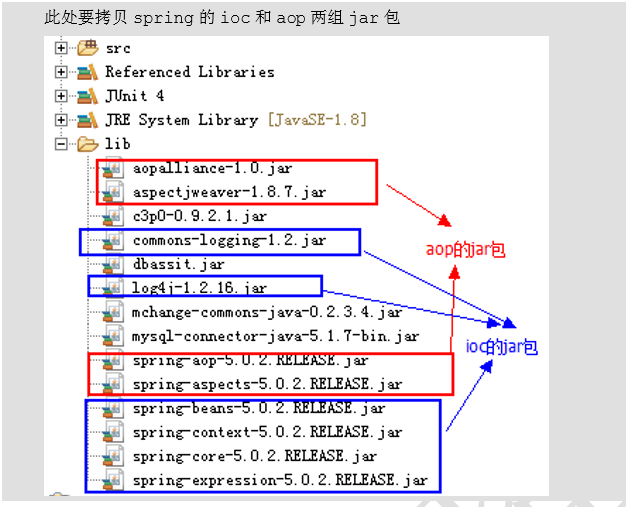什么是AOP?
AOP意为:面向切面编程,利用AOP可以对业务逻辑的各个部分进行隔离,从而使得业务逻辑各部分之间的耦合度降低,提高程序的重要性,同时提高开发效率
简单说就是:它就是把我们程序重复的代码抽取出来,在需要执行的时候,使用动态代理的技术,在不修改源码的基础上,对我们的已有方法进行增强。
AOP的作用:
在程序运行期间,不修改源码的情况下对已有的方法增强
减少了代码冗余,提高代码质量,维护方便
AOP的实现技术:
使用动态代理的技术(自行补充此知识点)
AOP的相关术语
- Joinpoint(连接点): 所谓连接点是指那些被拦截到的点。在 spring 中,这些点指的是方法,因为 spring 只支持方法类型的 连接点。(增强的方法)
- Pointcut(切入点): 所谓切入点是指我们要对哪些 Joinpoint 进行拦截的定义。 (所要增强的方法)
- Advice(通知/增强): 所谓通知是指拦截到 Joinpoint 之后所要做的事情就是通知。 通知的类型:前置通知,后置通知,异常通知,最终通知,环绕通知。
- Introduction(引介): 引介是一种特殊的通知在不修改类代码的前提下, Introduction 可以在运行期为类动态地添加一些方 法或 Field。
- Target(目标对象): 代理的目标对象。
- Weaving(织入): 是指把增强应用到目标对象来创建新的代理对象的过程。 spring 采用动态代理织入,而 AspectJ 采用编译期织入和类装载期织入。
- Proxy(代理): 一个类被 AOP 织入增强后,就产生一个结果代理类。
- Aspect(切面): 是切入点和通知(引介)的结合。(通知类)
学习 spring 中的 AOP 要明确的事 :
a、开发阶段(我们做的) 编写核心业务代码(开发主线):大部分程序员来做,要求熟悉业务需求。
把公用代码抽取出来,制作成通知。(开发阶段最后再做):AOP 编程人员来做。 在配置文件中,声明切入点与通知间的关系,即切面。:AOP 编程人员来做。
b、运行阶段(Spring框架完成的) Spring 框架监控切入点方法的执行。一旦监控到切入点方法被运行,使用代理机制,动态创建目标对 象的代理对象,根据通知类别,在代理对象的对应位置,将通知对应的功能织入,完成完整的代码逻辑运行。
环境搭建 :
导包:

附上包的网盘下载地址:
链接:https://pan.baidu.com/s/1hC13b1y4jUpoh89dhI2glg
提取码:sz1a
配置xml文件导入约束:
<beans xmlns="http://www.springframework.org/schema/beans"
xmlns:xsi="http://www.w3.org/2001/XMLSchema-instance"
xmlns:aop="http://www.springframework.org/schema/aop"
xsi:schemaLocation="http://www.springframework.org/schema/beans
https://www.springframework.org/schema/beans/spring-beans.xsd
http://www.springframework.org/schema/aop
https://www.springframework.org/schema/aop/spring-aop.xsd">
</beans>
编写servlet类 定义3个需要被增强的方法() ,及连接点
package AOP_servlet;
public class use_servlet implements interface_servlet {
public int select() {
System.out.println("查询成功");
return 0;
}
public void delete() {
System.out.println("删除成功");
}
public boolean insert(int i) {
System.out.println("插入成功");
return false;
}
}
编写通知类(切面),定义增强方法(切入点)
package AOP_logger;
public class logger {
//前置通知
public void before() {
System.out.println("before") ;
}
//后置通知
public void after() {
System.out.println("after");
}
//异常通知
public void throwprint() {
System.out.println("throw");
}
//最终通知
public void last() {
System.out.println("last");
}
}
AOP标签
-
使用 aop:config 声明 aop 配置
作用:用于声明开始 aop 的配置
<aop:config>
<!-- 配置的代码都写在此处 -->
</aop:config>
-
使用 aop:pointcut 配置切入点表达式
aop:pointcut: 作用: 用于配置切入点表达式。就是指定对哪些类的哪些方法进行增强。
属性: expression:用于定义切入点表达式。 id:用于给切入点表达式提供一个唯一标识
<aop:pointcut expression="execution( public void com.itheima.service.impl.AccountServiceImpl.transfer( java.lang.String, java.lang.String, java.lang.Float) )" id="pt1"/>
public 方法权限可以省略
方法类型可以用 * 表示 任意返回类型
包可以用 * 表示 *.. 表示当前包及其子包
类名可以用 * 表示 所有方法
方法名用 * 表示 所有方法
方法参数用 (..) 表示任意参数
开发中 一般为servlet中的类的所有方法增强 所以 "execution( * servtel.useservtel.*(..))"
-
使用 aop:aspect 配置切面
作用: 用于配置切面。
属性: id:给切面提供一个唯一标识。 ref:引用配置好的通知类 bean 的 id。
<aop:aspect id="txAdvice" ref="txManager">
<!--配置通知的类型要写在此处-->
</aop:aspect>
-
使用 aop:xxx 配置对应的通知类型
aop:before
作用: 用于配置前置通知。指定增强的方法在切入点方法之前执行
属性:
method:用于指定通知类中的增强方法名称
ponitcut-ref:用于指定切入点的表达式的引用
poinitcut:用于指定切入点表达式
执行时间点: 切入点方法执行之前执行
<aop:before method="beginTransaction" pointcut-ref="pt1"/>
aop:after-returning
作用: 用于配置后置通知
执行时间点: 切入点方法正常执行之后。
它和异常通知只能有一个执行 <aop:after-returning method="commit" pointcut-ref="pt1"/>
aop:after-throwing
作用: 用于配置异常通知
执行时间点: 切入点方法执行产生异常后执行。
它和后置通知只能执行一个 <aop:after-throwing method="rollback" pointcut-ref="pt1"/>
aop:after
作用: 用于配置最终通知
执行时间点: 无论切入点方法执行时是否有异常,它都会在其后面执行。
<aop:after method="release" pointcut-ref="pt1"/>
-
编写xml:
<?xml version="1.0" encoding="UTF-8"?>
<beans xmlns="http://www.springframework.org/schema/beans"
xmlns:xsi="http://www.w3.org/2001/XMLSchema-instance" xmlns:aop="http://www.springframework.org/schema/aop"
xsi:schemaLocation="http://www.springframework.org/schema/beans
https://www.springframework.org/schema/beans/spring-beans.xsd
http://www.springframework.org/schema/aop
https://www.springframework.org/schema/aop/spring-aop.xsd">
<!-- 配置 Servlet类 IOC -->
<bean id="use_servlet" class="AOP_servlet.use_servlet"></bean>
<!-- 配置logger(通知)类 IOC -->
<bean id="logger" class="AOP_logger.logger"></bean>
<!-- 配置AOP -->
<aop:config proxy-target-class="true">
<!-- 配置切入点表达式 -->
<aop:pointcut expression="execution(* AOP_servlet.*.*(..))"
id="execution" />
<!-- 配置切面 -->
<aop:aspect id="aoplogger" ref="logger">
<!--配置切入点所要增强的方法 -->
<aop:before method="before" pointcut-ref="execution" />
<aop:after-returning method="after" pointcut-ref="execution" />
<aop:after-throwing method="throwprint"
pointcut-ref="execution" />
<aop:after method="last" pointcut-ref="execution" />
</aop:aspect>
</aop:config>
</beans>
-
环绕通知:
<!--配置切入点所要增强的方法 -->
<aop:around method="around" pointcut-ref="execution"/>
配置类:
package AOP_logger;
import org.aspectj.lang.ProceedingJoinPoint;
public class logger {
// 前置通知
public void before() {
System.out.println("before");
}
// 后置通知
public void after() {
System.out.println("after");
}
// 异常通知
public void throwprint() {
System.out.println("throw");
}
// 最终通知
public void last() {
System.out.println("last");
}
// 环绕通知
public void around(ProceedingJoinPoint pjp) {
try {
before();
// 切点方法执行
pjp.proceed();
after();
} catch (Throwable e) {
throwprint();
e.printStackTrace();
} finally {
last();
}
}
}
aop:pointcut: 作用: 用于配置切入点表达式。就是指定对哪些类的哪些方法进行增强。 属性: expression:用于定义切入点表达式。 id:用于给切入点表达式提供一个唯一标识 <aop:pointcut expression="execution( public void com.itheima.service.impl.AccountServiceImpl.transfer( java.lang.String, java.lang.String, java.lang.Float) )" id="pt1"/> 2